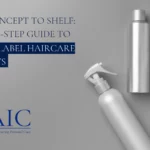A cosmetics label the first form of marketing and advertising a consumer sees. It introduces your product to the intended consumer. It’s an essential determining factor in selling the item because it directly influences how a consumer perceives the product.
Appearance plays a significant role, but so does the information presented on the label. More than ever, consumers are conscious of the ingredients used in products and the purpose of the product. The label differentiates the product from competing products, and a great label can increase the perceived value of a product in the eyes of the consumer.
It’s imperative to have a comprehensive grasp of the labelling requirements before putting your product on the market. Even the slightest inaccuracy or exclusion, like forgetting to include the barcode, may prohibit a successful product launch which can negatively affect a brand owner’s ability to sell.
Labelling requirements for South African cosmetics are detailed in the Foodstuffs, Cosmetics and Disinfectants Act (Act 54 of 1972) and the various amendments to the Act. Where cosmetics are concerned, there is also a “Cosmetics Advertising Code of Practice” for South Africa. This Cosmetic Code is compiled and managed by the cosmetic industry through the Cosmetic, Toiletry & Fragrance Association of South Africa (CTFA) and submitted to the Advertising Regulatory Board (ARB) for inclusion in the ARB Code on an annual basis.
How is the term ‘Cosmetics’ defined according to SA regulations?
Before we look at what should appear on your cosmetics label, we should start by looking at what is defined as ‘cosmetics’ according to the Foodstuffs, Cosmetics and Disinfectants Act (Act 54 of 1972).
“‘Cosmetic’ means any article, preparation or substance (except a medicine as defined in the Medicines and Related Substances Act (Act 101 of 1965)) intended to be rubbed, poured, sprinkled or sprayed on or otherwise applied to the human body, including the epidermis, hair, teeth, mucous membranes of the oral cavity, lips and external genital organs, for purposes of cleansing, perfuming, correcting body odours, conditioning, beautifying, protecting, promoting attractiveness or improving or altering the appearance, and includes any part or ingredient of any such article or substance.”
The Cosmetics Advertising Code of Practice makes the following statements per cosmetics regulations.
Scope includes the following:
The definition of what is considered cosmetics specifies six functions as per the scope, namely:
- To clean
- To perfume
- To change appearance
- To correct body odours
- To protect
- To keep in good condition.
If a product does not have at least one of the functions listed above as its primary purpose, then it is not considered a cosmetic.
The field of application of cosmetics is:
- The epidermis
- The hair system
- The nails
- The lips
- The external genital organs
- The teeth
- The mucous membranes of the oral cavity
Products intended to be ingested, inhaled, or applied to body parts not covered by the above definition are not considered cosmetic products.
What is required to be included on cosmetics labels?
By law, a cosmetics label needs to include:
- Brand name
- Product name
- Manufacturer/packer/distributor name and street address
- Country of origin
- Manufacture and expiry dates
- Batch number
- Product size or weight
- List of ingredients with the word ‘Ingredients:’ at the start of the list
- The names of any preservatives or colourants used in the product
- If a nutritional claim is made, the label must contain a nutritional table.
Other important legal requirements include:
- The label must be in English.
- Any product with healing or medical claims must be registered at the Medical Control Council (MCC).
- Any product with slimming or muscle enhancement claims must be registered at the MCC.
- The labels may not make claims that could be misleading to the consumer.
- The products may not contain banned ingredients, such as hydroquinone (used for skin lightening).
Recommended Guidelines
- Label Warnings – Cosmetics that could endanger customers if misused must have the proper label warnings and usage instructions. The declarations must be obvious and prominent. Examples of goods that demand such disclosures include children’s bubble bath products, feminine deodorant sprays, and cosmetics in self-pressurised containers (aerosol products).
- Tamper-Resistant Packaging – All cosmetic feminine hygiene goods (such as douches and tablets) and liquid oral hygiene products (such as mouthwashes and fresheners) must be put in tamper-resistant containers when sold at retail. A package is deemed tamper-resistant if it features an indicator or barrier to the entrance that, if breached or missing, warns a consumer that tampering has occurred (e.g., a shrink or tape seal, sealed carton, tube or pouch, aerosol container). To prevent substitution, the indication must be distinctive in the design (breakable cap, blister) and look (logo, vignette, other illustration). The immediate container, the outer container, or both may be included in the tamper-resistant feature. The consumer must be made aware of the tamper-resistant feature via a statement that is prominently displayed on the packaging. If the tamper-resistant function is compromised or absent, this statement must not change.
The above is a general summary of what should appear on your cosmetics label. Contact AIC for information that should appear on your white label items – for your label design and printing convenience.
For more detailed and further regulations, you can refer to the Cosmetics Advertising Code of Practice. it is advisable to seek expert advice and counsel before marketing, advertising, and launching your product to the South African market.
Sign Up
You can quickly sign up for our blog and receive updates and news in your inbox. Learn about sales, new products and new formulations.




